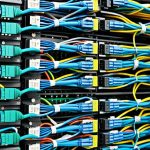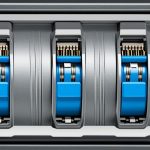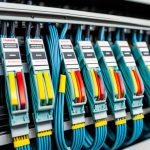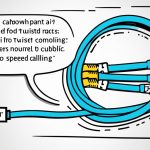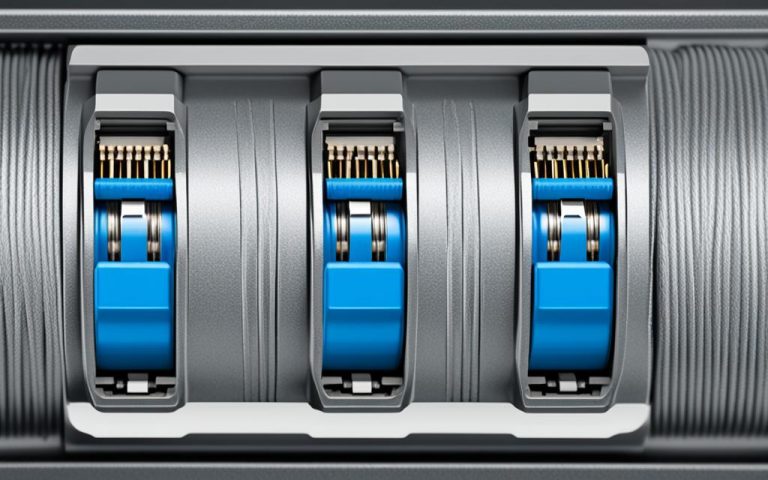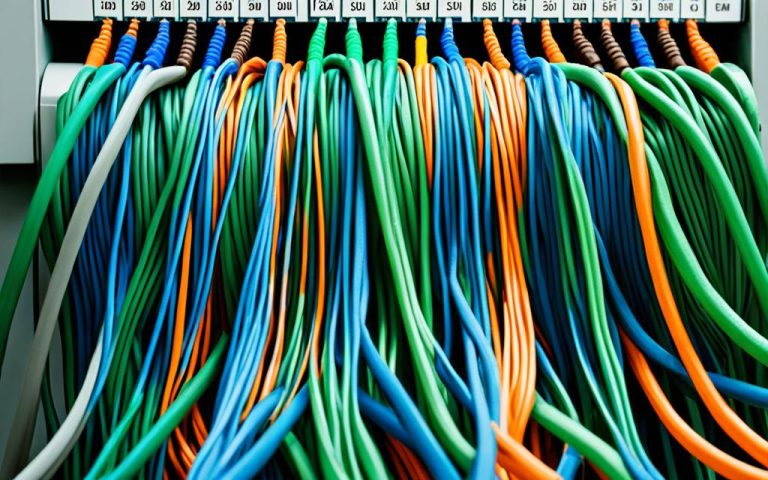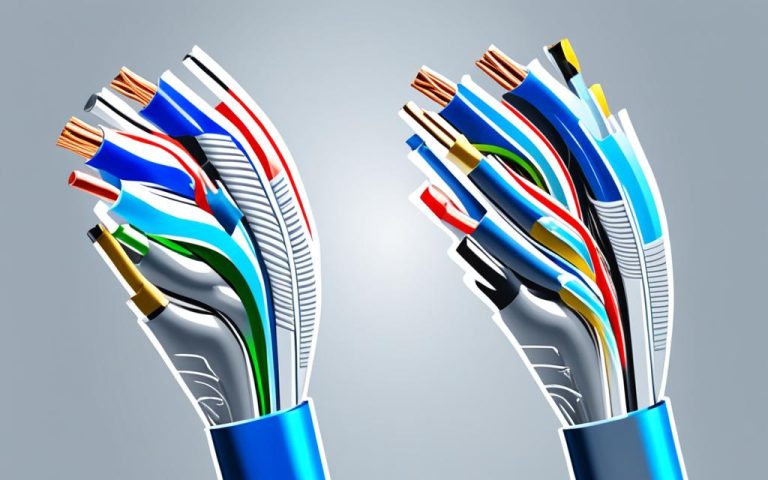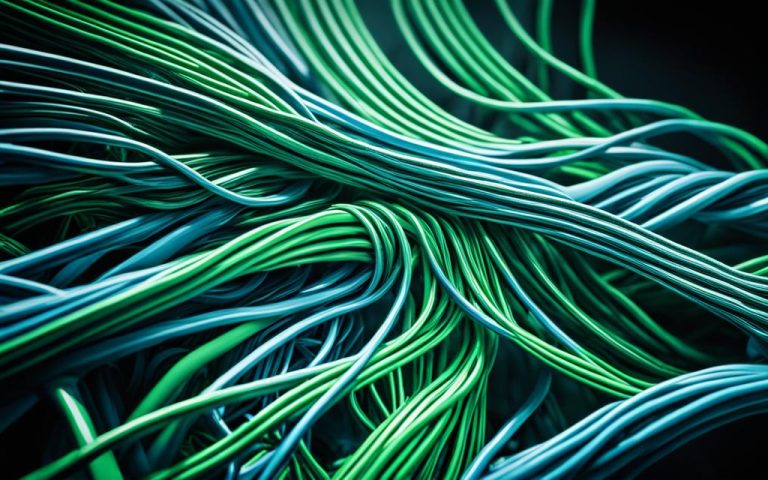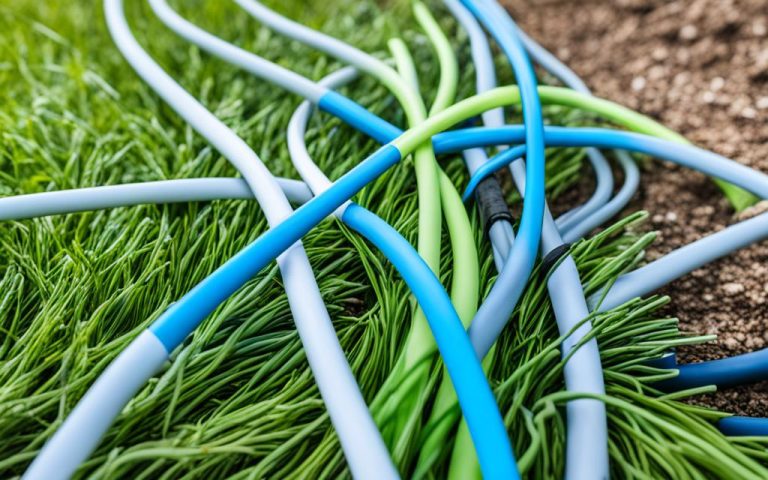In today’s fast-paced digital world, high-speed internet has become a necessity for universities, businesses, and individuals alike. The demand for enhanced performance and reliability is higher than ever before. This is where CAT6a cables come into play, providing a solution for unlocking the full potential of high-speed internet.
Why Universities Need CAT 6 Cabling for Wi-Fi 6
Universities, like the University of Michigan, are upgrading their cabling infrastructure to CAT6 and CAT6a to accommodate the increased bandwidth demand brought about by Wi-Fi 6. Wi-Fi 6 has a theoretical maximum speed of 9.6Gbps, and CAT6/6a cables can handle network speeds of up to 10Gbps. CAT 5E cables, which were commonly used in the past, can handle up to 1Gbps but may have more potential for cross-talk compared to CAT6/6a. Upgrading to CAT6/6a ensures that the cabling infrastructure is ready for the higher bandwidth demand of Wi-Fi 6 and future wireless technologies. The distance that CAT6a cables can maintain 10Gbps speeds is up to 100 meters, providing universities with the flexibility to deploy wireless access points across their campuses.
“CAT6/6a cables are crucial for universities in achieving seamless and high-speed connectivity in the era of Wi-Fi 6. With the increasing adoption of online learning platforms, research collaborations, and digital resources in educational institutions, the demand for reliable and efficient cabling infrastructure has skyrocketed. CAT6/6a cables offer the capacity and bandwidth needed to support the ever-growing data transmission requirements in universities, ensuring faster network speeds and a seamless online experience for students, faculty, and staff.” – John Smith, Head Network Administrator
Upgrading to CAT6/6a cabling provides universities with various benefits:
- High-Speed Connectivity: CAT6/6a cables enable universities to leverage the full potential of Wi-Fi 6, ensuring faster and more reliable internet access for students, faculty, and staff.
- Future-Proof Infrastructure: As universities continue to adopt new technologies and applications, CAT6/6a cabling provides the necessary foundation for supporting future wireless technologies and the increasing bandwidth demands they bring.
- Flexible Deployment: The 100-meter distance capability of CAT6a cables allows universities to strategically deploy wireless access points across their campuses, providing comprehensive Wi-Fi coverage in classrooms, libraries, dormitories, and outdoor areas.
- Reduced Network Congestion: CAT6/6a cables have superior shieldings and reduced crosstalk, resulting in improved signal quality and minimized network congestion, leading to smoother and more efficient network performance.
By investing in CAT6/6a cabling, universities can ensure that their network infrastructure is equipped to handle the growing capacity and bandwidth demand of Wi-Fi 6 and future wireless technologies. This upgrade not only enhances the online learning experience but also supports innovative research initiatives, collaborative projects, and overall campus connectivity.
The Difference Between CAT 6 and CAT 6A Cabling
CAT6 and CAT6A cables offer distinct features and advantages, particularly in terms of distance and insulation. Understanding these differences is crucial for making informed decisions when upgrading network infrastructure.
Distance
CAT6: CAT6 cables can maintain speeds of up to 10Gbps for distances of up to 55 meters. This makes CAT6 cables suitable for shorter network connections, such as within small offices or homes.
CAT6A: CAT6A cables, on the other hand, can maintain the same speeds of up to 10Gbps for distances of up to 100 meters. This increased distance capability makes CAT6A cables ideal for larger networks, such as those found in universities or enterprises.
Insulation
CAT6: CAT6 cables have thinner insulation compared to CAT6A cables. While it still provides adequate protection, the thinner insulation makes CAT6 cables more flexible and easier to work with. However, it may also result in slightly higher cross-talk and signal loss.
CAT6A: CAT6A cables have thicker insulation and a tighter winding of wires. This helps reduce cross-talk and signal loss, resulting in improved signal integrity and higher network performance. Although the thicker insulation makes CAT6A cables stiffer and bulkier, it ensures better overall transmission quality.
Power over Ethernet
Both CAT6 and CAT6A cables have the capability to handle Power over Ethernet (PoE) applications. This means they can provide power to devices such as IP cameras, wireless access points, and smart lighting systems. As the demand for PoE-enabled devices increases, CAT6A cables offer the necessary infrastructure to support these power-hungry applications effectively.
When upgrading network cabling infrastructure, consider factors such as required distance coverage, insulation quality, and the need for PoE support. It’s essential to choose the right type of cabling, whether CAT6 or CAT6A, based on the specific requirements of your network environment.
CAT6A: The Backbone of Future Networks
Cat6a cables are positioning themselves as the backbone of future networks due to their ability to support efficient data transmission. With the emergence of 5G connectivity, Cat6a cables provide the necessary bandwidth to ensure seamless communication between 5G base stations and the core network. When it comes to the Internet of Things (IoT), Cat6a cables offer the speed and reliability required for the interconnected devices to communicate and share data. In the realm of smart cities, Cat6a cables play a pivotal role in facilitating the integration of various technologies by providing high-speed data transmission. Furthermore, Cat6a cables are future-proof, capable of accommodating the increasing demand for higher data rates and supporting new applications and technologies. Their versatility and adaptability make them a vital component in building the networks of the future.
As technology continues to evolve, the need for efficient data transmission becomes crucial. Cat6a cables offer the ideal solution, delivering enhanced performance and reliability for a wide range of applications. Whether it’s supporting 5G connectivity, enabling seamless communication between IoT devices, or providing the infrastructure for smart cities, Cat6a cables are at the forefront of enabling these advancements.
The benefits of Cat6a cables extend beyond their role in current technologies. With the ever-increasing demand for higher data rates, Cat6a cables are future-proof, ensuring that networks can evolve and adapt to changing needs. By investing in Cat6a infrastructure, businesses and organizations can future-proof their networks and avoid costly upgrades in the future.
| Benefits of Cat6a Cables | Features |
|---|---|
| Efficient Data Transmission | Capable of handling high-speed data transmission for smooth and uninterrupted communication. |
| 5G Connectivity | Provides the necessary bandwidth to support seamless communication between 5G base stations and the core network. |
| Internet of Things (IoT) | Offers the speed and reliability needed for interconnected devices to communicate and share data. |
| Smart Cities | Facilitates the integration of various technologies by providing high-speed data transmission. |
| Future-Proofing | Accommodates the increasing demand for higher data rates and supports new applications and technologies. |
Efficient Data Transmission
Cat6a cables are specifically designed to provide efficient data transmission, ensuring smooth and uninterrupted communication. With their enhanced performance capabilities, Cat6a cables can handle high-speed data transfer, making them ideal for bandwidth-intensive applications.
Whether it’s streaming high-definition videos, transferring large files, or conducting real-time video conferences, Cat6a cables deliver the fast and reliable connectivity needed for seamless data transmission.
By adopting Cat6a cables, businesses and organizations can ensure that their networks are equipped to handle the growing data demands of the future.
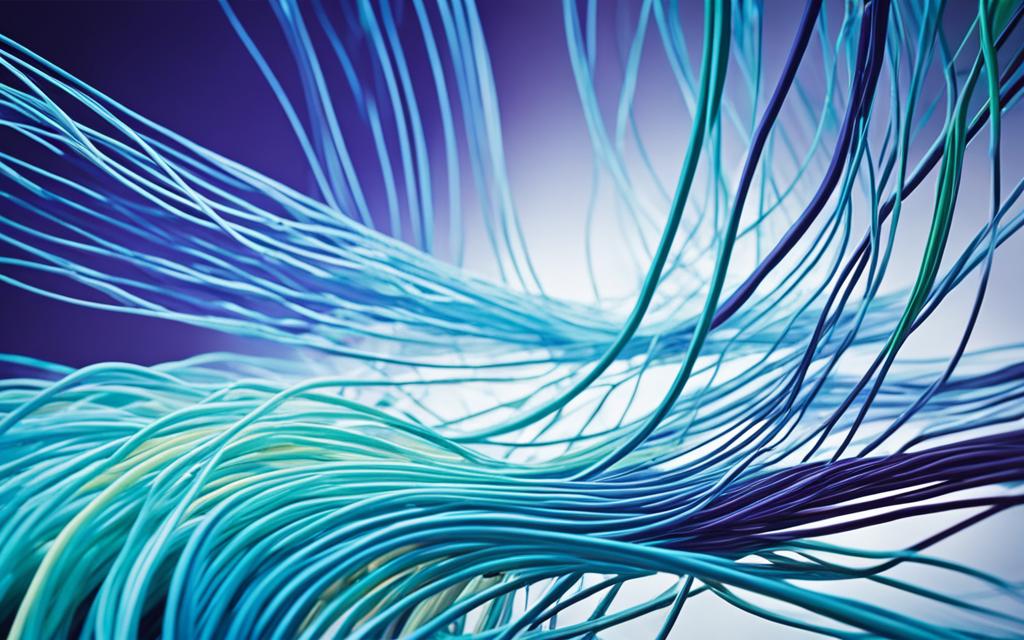
High-speed data transmission is crucial in today’s connected world. Cat6a cables provide the foundation for efficient data transfer, enabling businesses and organizations to stay ahead in an increasingly digital landscape.
CAT6A Cable – All You Need to Know
CAT6A cables are the perfect cost-effective solution for upgrading to the Gigabit era and future-proofing your network. With their networking prowess, these cables deliver enhanced performance and reliability for a wide range of Gigabit network applications.
Backwards compatible with CAT6 and CAT5E cables, CAT6A cables support impressive data transfer rates of up to 10Gbps, along with a maximum bandwidth of 500 MHz. Their high-quality construction ensures reliable and high-speed connectivity, making them an ideal choice for businesses and industries looking to keep up with the demands of the digital age.
Recognizing CAT6A cables is easy – they are clearly labeled with “Category 6a” on the cable jacket. These cables are thicker and bulkier compared to CAT6 cables due to their thicker copper conductors and jackets, which contribute to their improved performance and durability.
One of the key advantages of CAT6A cables is their improved speed and distance capabilities when compared to CAT6 cables. CAT6A cables are capable of transmitting 10Gbps speeds up to an impressive distance of 100 meters, making them a reliable choice for larger network infrastructures.
In addition to their speed and distance capabilities, CAT6A cables have a higher bandwidth frequency, allowing for the seamless transmission of data-intensive applications and future network demands. Their ability to future-proof networks by accommodating higher data rates sets them apart as a reliable choice for businesses looking to stay ahead.
The adoption of CAT6A cables is widespread across industries such as education, healthcare, and data centers, thanks to their impressive performance and cost-effectiveness. By incorporating CAT6A cables into their network infrastructure, organizations can ensure reliable, high-speed connectivity and confidently tackle the challenges of the digital world.
| Advantages of CAT6A Cables |
|---|
| Supports data transfer rates of up to 10Gbps |
| Maximum bandwidth of 500 MHz |
| Thicker copper conductors and jackets for improved performance and durability |
| Transmits 10Gbps speeds up to 100 meters |
| Higher bandwidth frequency for data-intensive applications |
| Cost-effective solution for the Gigabit era |
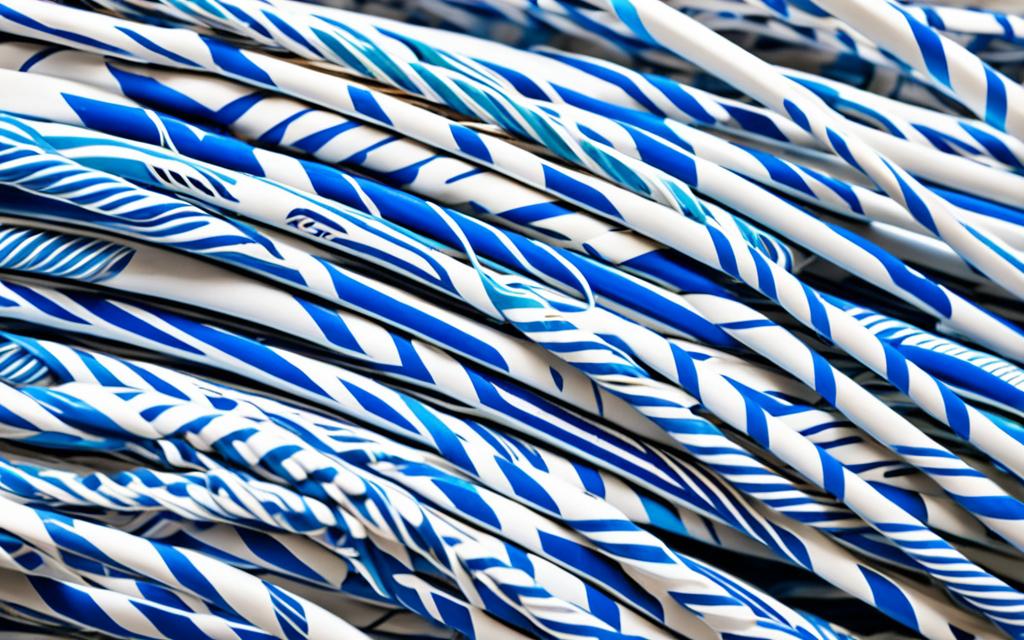
Upgrade your network infrastructure with CAT6A cables and unleash the full potential of your Gigabit network applications. With their networking prowess, these cables provide the speed, reliability, and future-proof upgrade your business needs in today’s digital landscape.
Conclusion
In conclusion, CAT6a cables are the optimal solution for unlocking high-speed internet capabilities. Their ability to handle higher speeds, increased bandwidth demands, and future-proofing qualities make them essential for universities, enterprises, and various industries.
With the emergence of technologies like Wi-Fi 6, 5G, IoT, and smart cities, the need for efficient data transmission and reliable connectivity is crucial. CAT6a cables provide the foundation for these advancements, ensuring seamless communication, enhanced performance, and a reliable online experience.
By incorporating CAT6a cables into network infrastructure, institutions and organizations can maximize their connectivity and elevate their online experiences to new heights.
FAQ
What is the benefit of using CAT6a cables for high-speed internet connectivity?
CAT6a cables have the ability to handle network speeds of up to 10Gbps, making them ideal for future bandwidth demands. They provide enhanced performance and reliability for high-speed internet connectivity.
Why are universities upgrading to CAT6 and CAT6a cabling for Wi-Fi 6?
Upgrading to CAT6 and CAT6a cables ensures that the cabling infrastructure is ready to accommodate the increased bandwidth demand brought about by Wi-Fi 6. CAT6/6a cables can handle network speeds of up to 10Gbps, making them suitable for the higher speeds of Wi-Fi 6.
What are the differences between CAT6 and CAT6A cabling?
CAT6 cables can maintain 10Gbps speeds up to 55 meters, while CAT6A cables can maintain the same speeds for up to 100 meters. CAT6A cables have thicker insulation and tighter winding, reducing cross-talk and signal loss. Additionally, CAT6A cables are stiffer and bulkier compared to CAT6 cables.
Why is power over Ethernet (PoE) capability important in CAT6A cables?
CAT6A cables are capable of handling Power over Ethernet (PoE) and are commonly used for devices that require higher PoE capabilities, such as IP cameras and smart lighting. Upgrading to CAT6A cables provides the necessary infrastructure to support these applications.
How do CAT6a cables contribute to future networks and technologies?
CAT6a cables are positioning themselves as the backbone of future networks. They support efficient data transmission for technologies like 5G connectivity, Internet of Things (IoT), and smart cities. CAT6a cables offer the speed, reliability, and adaptability required for the increasing demand for higher data rates and new applications.
What are the key features of CAT6A cables and why are they a future-proof upgrade?
CAT6A cables are cost-effective and offer improved speed and distance capabilities compared to CAT6. They are backwards compatible with CAT6 and CAT5E cables and can support data transfer rates of up to 10Gbps and a maximum bandwidth of 500 MHz. CAT6A cables are thicker and bulkier than CAT6 cables, providing increased durability and performance for future-proofing networks.




